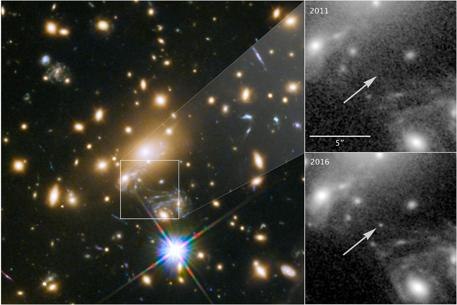
In a major breakthrough, astronomers have spotted the most distant star ever observed that lies 9 billion light years away from earth. A joint team of astronomers at the University of Minnesota and University of California captured the rare sighting using the Hubble telescope, and they believe it is the most distant individual star ever seen that is not a supernova.
Astronomers have officially named the star MACS J1149+2223 Lensed Star 1, but is being fondly called Icarus, after the Greek mythological character who flew too near to the sun on wings of feathers. The study report is now available in journal Nature Astronomy.
"For the first time ever we're seeing an individual normal star — not a supernova, not a gamma-ray burst, but a single, stable star — at a distance of 9 billion light-years," said Alex Filippenko, an astronomer at the University of California and the co-author of the study.
In normal cases, stars at such distance are often too faint to be identified individually, unless until they get exploded in a supernova. However, a rare cosmic alignment has made Icarus visible for astronomers in the earth. Astronomers made use of a process called "Gravitational Lensing" to capture this star.
Usually, the process of gravitational lensing allows astronomers to magnify objects by up to 50 times, but in the case of Icarus, things were different, and it was magnified 2000 times. A star which was briefly passing through the line of sight between Hubble and Icarus has helped astronomers to magnify Icarus to a far too great extent.
"We are looking back three-quarters of the way almost to the big bang. This star is at least 100 times farther away than the next individual star we can study, except for supernova explosions," said Dr Patrick Kelly, the lead author of the study from the University of Minnesota, reports the Guardian.
Researchers also made it clear that the additional brightness of Icarus is due to a magnification boost from a nearby star within the galaxy cluster.
"Usually the stars are magnified by about 600 times; that is just due to the cluster itself. But sometimes a star kind of floating in the middle of a cluster will also get in the right place and that will contribute additional magnification. That is what was responsible for the brightening of Icarus by a factor of four," added Kelly.
The new discovery is expected to help astronomers in shedding light on the evolution of the earliest stars in detail.









